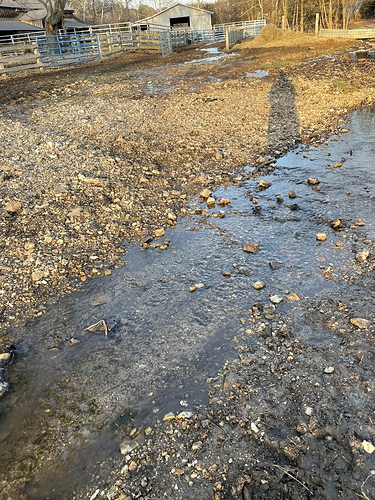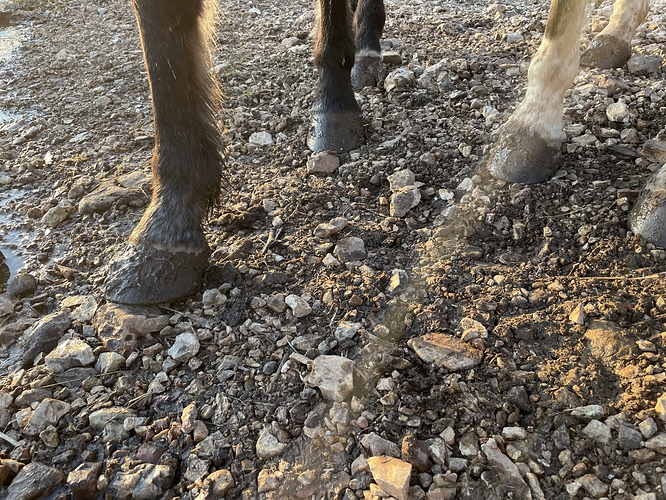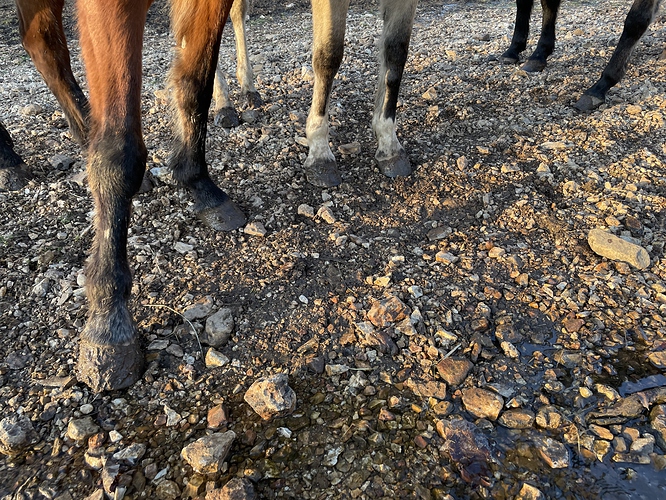Thanks that would be interesting. I’m thinking of making a seasonal water crossing. It certainly helps with back country riding when my dressage horses get out of the ring and learn how to navigate the real world.LOL
He does have bleaching in his mane and tail! I thought it was just from living out and sweating during the summer. I never considered that. Thank you for the info!
This isn’t a reliable indicator of cu/zn status. A horse with nd1 will fade/bleach to some degree no matter what, barring no sun exposure at all.
True, but for many it’s an indication of Cu/Zn status. My black bay KWNP faded and had red bleaching of his mane and tail which went away with cu/zn supplementation. He became a year round black. My bay Andalusian had red bleaching of his mane and tail with a yellow red coat color. After supplementing Cu/Zn his mane/tail are jet black and his coat is a deep dark red. My chestnut STB also showed signs of bleaching that when supplemented with Cu/Zn she stayed a vibrant red year round. My coach’s and friends’ horses who have supplemented with Cu/Zn because their horses showed bleaching had no more reddening of their manes/tails and had deeper coat colors. It’s an inexpensive to supplement and if there are no changes observed no harm. Cu/Zn are important nutrients used in more than hair pigmentation.
Here is the obligatory creek crossing for my domestic herd. They have to cross it to go just about anywhere away from the barn.
My foot and rock size
Horse hooves and rock sizes
It can be, but you can’t prevent all fading with nd1 horses. That’s their genetics. My black horse faded dramatically less once I upped the cu/zn, but it didn’t stop it
Yes, cu/zn are important, and often low in forages. But at some point, more isn’t better or more useful
Livestock should be fenced out of waterbodies. Hoof traffic & excess nutrient/bacterial causes large amounts of damage & degradation to aquatic ecosystems, stream channels & water supplies.
I would not make a horse that apparently has softer feet than the average horse walk around on rocks. If he otherwise had great feet and you wanted to get him used to walking on rocky terrain, that would be different.
This is generally true, but . . . if the water source and the number of livestock are managed carefully the ecosystem won’t be damaged. After all, deer and other wild animals drink out of creeks and ponds without damaging the ecosystem. Here in the Ozarks, several bands of wild horses (about 50 horses total) live in the Ozarks National Scenic Waterways along the Jacks Fork and Current Rivers. They drink out of the rivers and don’t damage the ecosystem. These horses are protected and managed by the National Park Service and the Missouri Wild Horse League. Here’s a link to a video about the horses: https://www.pbs.org/video/living-st-louis-wild-horses-shannon-county/
Getting back to the topic of this thread (toughening up thin hooves), putting down some rock around a water source will both help keep the mud down and toughen the horses’ feet.
The problem lies in the bank & substrate damage. If these are appropriately stabilized, damage can be minimized but that is expensive & takes expertise so it almost never happens. Which is why I have to speak up , because that’s part of my job. It’s not impossible & if people have questions about how to think about it on their own property (where cost shares are available), you are welcome to pm. I don’t want to derail the op further, so I will leave it at that. 
That is the law here for naturally occurring water courses. I have 2 creeks that are class a (fish bearing) and they are fenced off and have proper creek crossings. The man made ditch across the entrance to a field is allowed and collects surface run off. No damage to aquatic sytems, stream channels or water supplies.
for what it’s worth, i have two very close friends that are environmental scientists employed at EPA. BOTH of them have been to our farm many times, and they have been helpful when we’ve had to fence across a creek, when we’ve had to dig or fill a creek crossing and they gave good advice for this crossing i just showed everyone here with photos above. CROSSING creeks, when they are flattened and when there is good cover of rock on both sides adds virtually zero erosion. And, suffice it to say, is unpleasant enough a surface to discourage loitering. I manage several hundred acres organically, and avail myself of many environmental advisors. So though you make a very good point, making a GOOD crossing for the stream and for your animals hooves is done every day all across the country. And, livestock farmers actually even are smart enough to know how to/where to give access to ponds and lakes so their animals can drink right out of a pond. There is age old wisdom in rural america, and livestock farmers that have enough self-interest to know that what is good for the land is what is good for their animals.
Again yes, but not all horses are nd1 and the level of supplementation from the supplements people buy and feed at the recommended levels will not cause harm. Yes, feeding excessive amounts is not better or more useful.
You’re right, not all horses are nd1, your post just read like all fading is from a nutrition deficiency.
I do beg to differ on the “harm” comment though. Some of these forage balancers contain pretty high levels of cu and zn, and while not close to the toxic amounts (which is around 2500mg for a 500kg horse), they can put the cu/zn ratio pretty out of whack if the forage is providing a decent amount already.
Shoes with pads are on! Sweet fancy Moses, I hope this is the answer.


Hope that works and if it does, take x-rays to measure sole depth again in six months and you may be able to leave them off then, may not need them permanently.




